Running Tips and Resources

Walking/jogging: getting started
If you are preparing for your first attempt at entering a walking/jogging/running event, congratulations. The benefits are too many to count. We at OHSU Sports Medicine can offer some basic advice to keep healthy and well while training for and while completing your event.
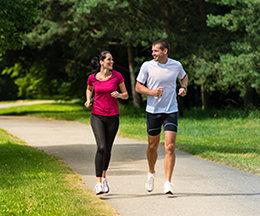
- If you are over the age of 35 (men) or 45 (women), and have not had a basic medical check-up, please consider scheduling a physical to discuss exercise and your health. This is especially important if you or your family members have a history of heart disease, diabetes or other chronic medical conditions.
- Set goals. Try to keep yourself on track. Make a calendar: Initially, it will be easiest to block out time in your day to walk, if not every day, then every other day. Don’t sweat the details: Don’t worry about how long you go, just do it! Eventually you can increase your time and distance leading up to the event.
- Pace yourself. If you have never participated in an event like Shamrock, or are going to be doing a distance that is longer than you are used to, take time to gradually lead into the event. Four to six weeks is a good safe time to give yourself time to get into the exercise mindset and gradually increase your distance.
- Listen to the aches. If you notice soreness, pain or other changes in your body, get seen by a sports medicine specialist. Many walking and running injuries have simple solutions by changing form, shoes or doing strengthening exercises. The sooner problems are addressed the better.
- Above all, have fun.
Exercise is the best medicine for many medical problems. It is good for our hearts, our minds and our joints. But it is important to have a safe approach to make sure you are not putting yourself at risk while training.
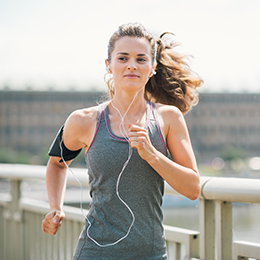
- Tell someone where you will be going and how long you will be training.
- Wear a form of identification, in the worst case scenario that you have an emergency and cannot identify yourself. There are many bracelets, charms and other items designed to be worn while exercising.
- Consider bringing a phone. Although exercise is often a good escape from the busy world, having a phone in case of an emergency is a great idea. Turn the phone off so you are not distracted, but have it on hand if you need to call for help.
- Always wear visible clothing, especially if you are exercising when it is not light out. If others cannot see you, you are at risk.
- Stick to commonly traveled paths, running trails or tracks to ensure that you are in well-lit, safe environments. If walking in neighborhoods, remember that not all cars might yield to pedestrians.
- Be careful if using headphones. Exercising with headphones is a joy for many. However, they will decrease your awareness of your surroundings. If someone is passing you on a trail, you may not hear them. When running in urban environments, be cautious as headphones may decrease your awareness of cars or other vehicles passing you.
- Fear the auto. Even though there are rules for cars -- at intersections, on straightaways, and crosswalks -- always assume that a car does not see you, or is not going to stop for you at an intersection. This will reduce the chances that you are following the rules, but the driver is not, which may lead to an accident.
Running: getting started
New to exercising?
Before starting a running program (or any exercise program), it’s important to assess your health and fitness status: make sure to talk to your health care provider. Diabetes, high blood pressure and heart disease are just some of the chronic health problems that may require special testing or screening before you start an exercise program.
Here are some questions to ask your provider:
- Are there special concerns about exercising with my health problems?
- Do any of my medications affect my ability to exercise?
- Do I need any lab work or testing to make sure I am safe to exercise?
Have old or new injuries?
Let’s face it, injuries happen. Many people have injuries that are present when starting a walking/jogging/running program. Maybe it’s a nagging hamstring injury that just won’t resolve. Or it’s the aching knee you injured in high school that still hurts after runs. If you have lingering issues that have never been addressed, consider seeing a sports medicine specialist to discuss preventive/healing approaches to help you reach your goal for training.
New to racing?
The key is to assess where you’re starting. If you’re inactive and starting a running program, a “couch to 5k” or “walk to run” program might work well. If you have run a 5k or 8k race in the past and are hoping to step up to a longer distance, consider how much time you have to train and how long you’re planning on training for this race. Helpful tips include:
- Keeping a training/running log
- Starting slow and build over time
- Avoiding large increases in miles or speed in a short time frame
- Setting goals that are realistic for your schedule and time
Want to run faster?
What steps will you take to change the results you have gotten in the past? Are you going to work with a coach? Do you have a training program in mind? You may want to consider training techniques that include intervals, sprints and tempo runs.
Running is a simple and cost-effective way to get fit and stay in shape. Getting started is often half the battle. To help you along, our OHSU Sports Medicine physicians have compiled some guidelines for taking your running or walking to a new level.
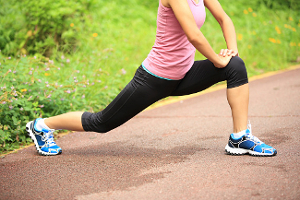
- Begin with a warm up: Develop a dynamic series of stretches to increase blood flow to the working muscles and increase the functional range of motion around the major joints. View warm-up stretches from Runner’s World
- Use the Talk Test: A common training error in those revisiting their running program is to start out simply running too quickly. Endurance is the main training goal, and it's best achieved by training at a moderate intensity level. How do you know if you're running too fast? The simple test is to see if you can talk. If you're unable to hold a casual conversation while running, you are likely going too fast.
- Stay healthy: Injuries are an unfortunate but common part of running. If you have a history of joint injury or develop injuries while running, be sure to get evaluated quickly. Many runners will push through pain and ignore important signs from their body. OHSU Sports Medicine specialists can help address problem areas and come up with recovery programs that will get you back to running quickly and safely.
- Make a training plan: Flying by the seat of your pants can make for an interesting life, but it isn't a good approach to a training program for runners and walkers. Find the best fit for you, but consider that you need to accurately evaluate your current fitness and strive for a conservative increase in weekly mileage.
Running should be easy, right? It’s inexpensive. Good for your health. So…what’s the catch? Why do so many walkers/joggers/runners struggle while training for a race or running event?
Here are some tips to keep you on schedule and maintain the energy needed to complete your race day successfully.
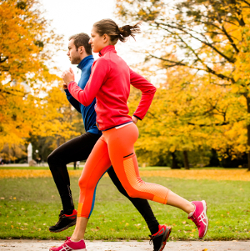
- Set a goal. There are many different approaches to running, whether it’s pushing for a new personal record (known as a “PR”) or running your first race. Focusing on the end goal rather than on a day-to-day approach can be easier to stay on task. Another helpful tip is to set several small goals on track to reaching your major goal.
- Keep a training log. How far? How fast? How did the run feel? Did you drink water before, after or during? The more information you can collect, the more you can analyze your performance. For example, you might find runs later in the day are harder for you, so try running earlier in the day.
- Join a running group or get a running partner. Group/partner running is a great way to have fun, share training successes challenges and motivate on hard days.
- Increase cautiously. Many running injuries are caused by overtraining. A commonly quoted statement is to increase by only 10 percent per week. For instance, if you are used to running six miles a week (two miles three days a week) – and your goal is to get to 12 miles a week, increase weekly miles by about 0.6 miles for the first week. This will keep your changes slow and gradual, helping prevent injuries.
- Listen to your body. If you have a nagging injury, or your training schedule is causing you to have consistent pain or problems, get it checked out. Blindly pushing through pain hoping for relief is a common way to get injured.
- Take rest days. We all need rest. Make sure your training program has at least one rest day to allow your body to heal and recover..
- Cross-train. A key component of healthy running is getting stronger. Many cross-training programs focus on building strength in key muscles that are key to good running form and injury prevention.
- Expect hard days. Watch out, hard days are coming. All runners experience tough days, where your legs feel like they are filled with concrete. Do your best to safely finish your training these days and try not to let yourself get dragged down by them.
- Get good shoes. A good pair of running shoes will make your running experience more enjoyable and help you to avoid injury.
- Have fun. Remember this more than anything else. This is what running is all about. Try to make your running sessions a highlight of your day.
Fueling (hydration and nutrition) for running can be broken down into four main categories: 1) daily intake, 2) pre-race, 3) during race and 4) after race.
There are many opinions about many different aspects of fueling. The goal of this blog post is to discuss key principles which will serve as a foundation for all on staying well-fueled. These guidelines are collected from the American College of Sports Medicine .
Daily recommendations
- Daily carbohydrate: 6 to 10 g/kg/d. For a 70kg (154-pound) person, this would be 420-700 grams of carbohydrate per day.
- Daily protein: 1-1.3 g/kg/d for most people. For a 70kg (154-pound) person, this would be 70-90 grams of protein per day. If you are working on strength–building, you may want to increase your protein to 1.3-1.7g/kg/day.
- Daily fat intake: Should be only 20-35 percent of your total energy consumption.
- Stay well-hydrated. This is hard to define. Common factors include season (warmer in summer), daily exercise load and energy expended.
Before race/exercise
- For hydration: Four hours prior to exercise, drink 350-500ml water or sports beverage.
- For energy: Your needs will vary depending on the duration and intensity of your exercise. For longer events, you should eat a small meal/snack that is mostly carbohydrate and some protein about four hours prior as well.
- Many races start early in the morning, so getting fueled four hours prior to your event might be hard. The key concern for a runner here is to make sure not to fuel too close to your race, which might cause stomach distress, nausea or possible vomiting. Each athlete needs to experiment with his or her own pre-race fueling –size, volume, type (bars/chews/etc.) and time prior to exercise.
During race exercise
- Exercise sessions of 30 minutes or less typically do not require during-race fueling.
- 30-60 minutes is debated: Some athletes may benefit from fueling during race, while others may not.
- It is clear that people exercising 60 minutes or more benefit from exercise fueling.
- What you drink during the race should have 6-8 percent carbohydrate. This is standard carbohydrate dose in most sports drinks.
- In a longer race, try to fuel in small frequent doses (i.e., every 20 minutes) as opposed to one large intake.
- It is harder to determine how much liquid to consume during a race, as every athlete is different. If consuming liquids during a race, 8-12 ounces every 20-30 minutes of exercise is a safe starting point.
After race/exercise
- As discussed above for during-race fueling, after-race fueling is linked with duration of exercise.
- It is thought that people will recover "better" from longer races with post- race hydration and nutrition.
- The right amount to fuel after a race differs for everyone: Try different approaches to see what works best for you.
Pearls
- NEVER start a new fueling plan on race day. Practice on your training runs to get a plan that works for you.
- An important point is acknowledging that it is possible to harm yourself by drinking too much. This condition is not common and is referred to as exercise-induced hyponatremia.
- Experiment with your fueling and hydrating plan. No one plan will work for everyone.
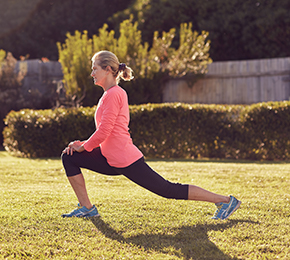
Introduction
This program is designed to minimize the risk of common overuse injuries associated with track and field training and distance running. It can be implemented in 10-15 minutes and no equipment is necessary. The specific exercises and stretches in this program were selected for their ability to target key areas where weakness or restriction may increase the risk of overuse injury. These exercises and stretches can be used in conjunction with current warm-up and stretching routines. They are not designed to replace current routines, only to serve as a supplement.
Knee to chest x 15 meters
Standing tall with shoulders square, lift leg brining knee to the chest with both hands. Maintain a slight bend in the knee for the straight leg activating quadriceps and hamstrings. Hold the knee to the chest for a three second count focusing a stretch on the hamstrings and gluteal muscles. Step forward and repeat on the other leg until 15 meters are covered.
Quad stretch x 10 meters
Standing tall flex knee and hold with the hand on same side of the body. Make sure to face forward and keep your shoulders above your hips while flexing knee. Hold leg at the ankle and resist the flexed knee by pushing into the hand holding it for a three second count. Relax the resistance and stretch again for a moment. Step forward and repeat with the other leg until 10 meters are covered.
Lunge and trunk flex x 15 meters
Lunge forward keeping the knee above the supporting foot. Lunge down as far as comfortable without resting the knee on the ground. Once in a stable lunge position, flex at the trunk in the frontal plane towards the side with the forward leg. Hold for a moment and feel the stretch through the iliopsoas on the extended leg's side. Step forward and repeat on the opposite side until 15 meters are covered.
Runner touch x 15 meters
Flex at the hip until the knee is above the height of the pelvis. Hold this position and then reach forward moving the flexed hip backwards into and extended position in a gradual and controlled manner. The length to achieve this movement should occur in the hamstrings and gluteal muscles. Descend until you can go no further without flexing the lower back. Return to the original position with flexed hip. Step forward and repeat on the opposite leg until 15 meters are covered.
Running tools and racing tips
"Any runner who denies having fears, nerves, or some other kind of disposition, is a bad athlete, or a liar." Olympian Gordon Pirie.
If you have raced before, you will agree with this statement You may already be having fears, nerves or feeling of anxiety as race day approaches. Just like your preparation and training for the race, the nervous energy that develops on race day can be trained and harnessed.
Goal # 1: avoid surprises
Weather. Check the forecast several times leading up to race day and make plans for the expected weather.
Know the course If you have not yet, check the course route. This will help you know what to expect. Look for highlights/visual cues.
Plan the time frame 1-2 days prior to the race. As much as possible, control your schedule . Go to sleep at a scheduled time. If you are doing any cool-down running, stick to your plan. Try to avoid any changes that may throw your mindset off.
Rehearse your pre-race routine. Make sure you know what time your race starts. If you are planning on getting to the start area early (which is advised), prepare for what you are going to do with that time. That way you are not caught with downtime which can give your mind time to start psyching itself out.
Goal #2: prepare for surprises
No matter how hard you prepare, you will likely have something happen that you were not prepared for. Cramps. Racing by yourself. Racing with a group. GI/stomach issues. Blisters. Bonking/hitting the wall. Gear/clothing malfunction.
There is a different answer to how each runner will handle these situations. Take a few minutes prior to race day to think out your plan for these situations.
Goal # 3: focus on what you can control
Don’t dwell on failures you may have had during training. This is now the past. You cannot change this.
Mental vs. physical fatigue. This is a key concept in training and racing. Often, then mind, if not trained, may send signals to your consciousness that you are tired or that you should stop. Mastering the inner voices in your mind is key to calming your mind during the race.
Have a positive mind. Relax. Have fun. Visualize the finish you want. If you are trying to finish, picture yourself crossing the finish line. Picture your face when you crush your PR. Implement these mental cues when the mind and body are struggling on race day.
Repeating a positive thought goes a long way to calm the mind.
More than anything else: Focus on having fun. Race day is here. Your hard work WILL pay off.
Selecting a running shoe can be quite a challenge. Both minimalist/barefoot and maximal cushioned shoes have exploded in popularity. One large shoe company settled a lawsuit related to exaggerated and misleading health benefits of their products. There are more manufacturers in the marketplace with more offerings.
Here are some helpful terms:
- Minimalist shoes: very low-profile shoes with minimal cushioning and support.
- Motion-control shoes: stiff, bulky shoes that are reinforced in the heel region to prevent motion in the foot and ankle. These are often recommended for very flat arches and weak leg muscles.
- Neutral shoes: middle of the pack: not too stiff, not too minimal in the cushioning.
- Maximalist shoes: Thick cushioning and rocker-designed to minimize impact on joints.
- Trail shoes: various stiffness and styles, with the primary difference being the tread on the sole of the shoe.
Making a decision can be tough. Be cautious of claims that shoes will make you faster, lighter, safer or stronger. There is little solid evidence to support those claims. Don’t get stuck on color or looks. Focus on the fit.
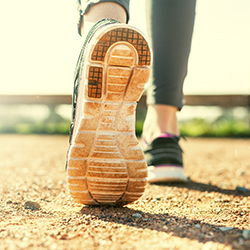
Here are some simple recommendations related to choosing a running shoe:
- Get your foot measured and buy a shoe from a reputable running shoe seller. Knowing your size is key and will always be a good start. Nothing can replace trying on different shoes in a store and feeling the actual difference of shoe types by spending time in them. The most important thing is the shoe should feel comfortable on: If not, there is a good chance it will not be comfortable while you’re running.
- If you are purchasing minimalist/less supportive shoes for the first time, slowly transition. One of the most common training errors with minimalist shoes is too rapid transition from conventional shoes to minimalist shoes. Minimalist shoes make your leg muscles work much harder. A safe recommendation is to take several months to transition by gradually building up time in the minimalist shoes.
- If you have a running shoe you have been using, and you have had minimal injuries or problems with running, be cautious of changing running shoes. For most runners’ goals, a shoe is not going to have large impact on time or pace. It is very challenging to make a clear recommendation to a runner that one shoe type is “better” than another. If a certain shoe has worked pretty well, it will likely continue to work well.
- Replace your running shoes periodically. With use, materials in the shoes start to break down. The most commonly mentioned change points are three to six months, or every 300 miles run.
- New runners should start in relatively neutral shoes. New runners put a lot of new stress on their joints and legs. It is safest to aim for the middle of the pack in terms of running shoes -- something forgiving and not too aggressive.
Runners looking to decrease their times and improve race performance will often experiment with speed programs. Speed programs have potential for both harm and benefit. With the right approach, speed drills can be a good way to push your body and make improvements.
That said, they are typically not recommended for beginning runners. Ideally, speed work will be used once you have the basics, feel good with your form and have a good running routine. Starting a speed program prematurely can increase your chances of getting injured. When starting with speed workouts, make sure to prepare for increased soreness and have an easy or rest day following speed work. When starting a speed program. keep speed work to once a week.
Bursts. On your normal running route, find a smooth straightaway and run faster (“burst”) for about 15-20 seconds. The goal is not to do full speed, but a more accelerated speed than standard runs. Try to incorporate several bursts into your run. Build up to two or three burst sessions per week. As you gain confidence, you can increase intensity and duration of bursts.
Time. If you know your pace, say eight-minute miles for racing, create a running program that includes faster times. Plan on a three-mile run. After a warmup, run one mile at eight minutes per mile. The second mile, run the first half at eight- minute pace, then run the second half-mile at 7:45 pace. For the first half of the third mile, return to eight-minute per mile pace, then finish with a half-mile at 7:30 pace. Everyone will respond differently to the faster pace. Adjusting your speed will depend on how you are feeling after each speed day.
Another option is a local running track. Never been on a track before? Here are some basic tips:
- Make sure the track is open and not reserved for special events.
- Run counterclockwise (most common) .
- Confirm track size. The standard is 400 meters on the inner lane (lane 1). If you are on a standard track, the straightaways are 100 meters. Four laps is close to a mile.
- As you are getting used to running on track, and when doing slower work, stay on the outer lanes.
- Be alert. Often there is lots of action on and around a track. Avoid using earphones. Keep on the lookout for runners who are doing high-speed work -- and try to give them space.
Curves/straights. Use straightaways to run at a faster speed. Of course, this is all based on your current speed and capacity. Do not try to run at maximum full sprint speed, at least initially. Start running at about 85-90 percent of your full sprint speed. Run the straightaways, then walk the curves. If needed, walk the remaining lap (both straightaways and curves) until you recover.
If you feel these are simple or easy, consider working with a running coach who can design a custom speed program for you.
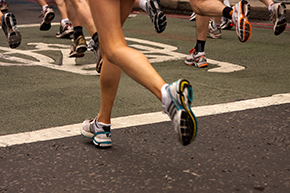
Have you ever done a strengthening program for running? Would you know where to start? If the answer is no, then it is likely that you are missing out on a critical aspect of running well and avoiding injuries. Not to mention, perhaps running faster.
A popular misconception is that if you are running a lot, you are getting stronger, and there is no need for strengthening. There are many benefits from maintaining your weekly miles. However, the repetitive motion of running often does not strengthen specific muscle groups adequately. Muscle weakness is a strong contributor to running-related overuse injuries. That’s why we recommend some additional exercises for building strength.
Most running strengthening programs focus on several big muscle groups.
- Core: This includes trunk, abdominal, lower back and hip muscles. The core is critical for good posture and control of trunk form while running.
- Glutes (buttocks): One of the most common weak points for runners (and everyone else) is your glutes. The glutes are critical for controlling pelvis stability, in addition to being part of the core system.
- Thighs: (quads and hamstrings)
- Calves: Two muscles on the back of the lower leg.
- Proprioception (balance work): During running, our bodies are constantly bearing all of the body's weight on one leg. If there is even subtle weakness, your form suffers, different muscle take different stress, and this can lead to injury.
Try this exercise: stand barefooted on a firm surface. Put your hands on your hips. Stand with all your weight on your right leg – with a small bend in your knee. Now close your eyes. Did you wobble? How long could you stand without losing balance? Try the same exercise on your left leg. This is a great test as well as exercise to work on subtle balance. Lots of wobbling or shaking in leg is a sign of muscle weakness.
A good goal is to find a routine that you can replicate. Consistency is the key. Ideally, strengthening exercises should be part of your weekly schedule. Two days a week is a minimum. Three to four days a week is ideal. A good strengthening program should be able to be completed in less than 20 minutes. Focus on body weight-based exercises. At most, use resistance bands, and light weights. Avoid exercise programs that involve heavy lifting.
Resources from Runner's World:
View a core strengthening routine
View a glute strengthening program
There is a simple principle in running medicine: exercise causes damage to muscle tissues. Damage to muscle tissue causes muscle soreness. Muscle soreness can be unpleasant for runners and also may affect performance (speed, distance, etc.).
Why is this? Can it be prevented? How does one manage this chain of events? It is too challenging to explain the many different physiological principles involved. Instead, let’s focus on one simple way to manage delayed onset muscle soreness (also known as DOMS): foam rolling.
Foam rolling is a popular and useful tool for runners and athletes of all types. Using a foam roller can help correct muscle imbalances, decrease muscle soreness, improve range of motion and relieving joint stress.
Where to work?
Commonly included areas to use with a foam roller include:
- Foot/arch
- Calves
- Iliotibial , or IT band (at knee and hip)
- Gluteus/buttock
How long to use?
Most programs call for spending 30-60 seconds on a given muscle area.
How often?
Foam rolling can be done either as part of a maintenance program to prevent and reduce injuries, or to work on areas that are experiencing soreness. Each person will find his or her ideal fit.
If you have not had running injuries and your body feels good, a foam roller may not be needed until you do have an injury. It can help manage chronic issues: For example, if you know your IT band is tight and gets painful on one side, a regular program (four or five days a week) of foam rolling may help keep pain from ramping up.
How to use?
The most effective way to use a foam roller is to apply your body weight to the roller. This can take some special planning, but can be done. See an athletic trainer for a demonstration of how to correctly position your body for foam rolling. The goal is to apply consistent pressure across the length of the region/muscle that you are working.
Should it hurt?
Maybe. Depending on how much pain you are experiencing from the sore area, you may feel some pain or soreness with foam rolling.
In general, if you are miserable the entire time you are working an area or if you have increased pain following foam rolling, you may need to stop. If a week or so of work with a foam roller does not help your pain, it is worth seeing a medical professional for evaluation.
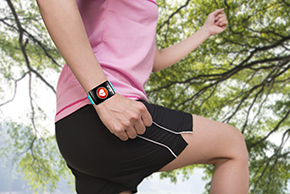
Most of you have seen the many devices - either on your phone or on your wrist - designed to track your steps. These are great devices that can help keep you on task for your exercise goals. Here are some tips on how to use them:
A great place to start is to do your “normal” activity and see what your step counts average. Take several days - write down number of steps - and then average them. This will let you know your current step count. From there, count the number of steps you get on your exercise regimen.
For example, if you walk for 30 minutes, see how many steps you get in that timeframe. Once you know your average for day and exercise event - the fun begins! Try to push yourself, by using the step counter. Here are some examples.
- Shoot for a goal to increase you daily steps by 5-10 percent. This leads to many healthy behaviors, such as parking further from the store or walking during lunchtime.
- Increase the number of steps per exercise session. This may require you to run walk faster.
- Increase the time you exercise to get to a goal number of steps.
Remember there is no magical number of steps. Some experts recommend a goal of 10,000 steps per day. However, if your baseline is only 3000-4000 or less, it is too much to jump to 10,000 without a good plan. Make a goal at increasing - by roughly 1000 steps per week - as you build to your goal number.
Here are some popular apps/step counters. There are many and this is just a list of common ones. The devices are more expensive - but often have many helpful functions—such as pacing and data recording.
Applications
Accupedo pedometer – Free (lite version); $3.99 for full version
Stepz (free)
Pacer (free)
Walker (free)
Devices
Adidas miCoach Fit Smart
Polar s3+
Garmin forerunner 620
Apple watch
Fitbit surge
Running injuries
What is PF?
Inflammation, tearing or damage to a dense layer of tissue in the arch of the foot.
What are the symptoms of PF?
PF is pain along the arch, typically on the inside part of the heel, and feels worse with activity or sometimes following activity. The pain may cause limping.
Why did I get it?
There are many reasons: One is overuse. Often when you start a new running program, your body is not used to the demands of training, and the stress across your foot is too high, causing the plantar fascia to become damaged.
A second reason is increased stress across the foot due to weakness somewhere else in body, from your hips through knees and into the feet. For example, weak hip muscles and tight calf muscles can both cause poor form when running, which leads to increased stress on your foot and plantar fascia.
Will it go away?
Fortunately, yes. Unfortunately, PF is often slow to resolve.
How do I get better?
There are several main components to recovery from PF:
- Rest: This means you do not have to stop exercising, but may need to reduce the amount of training you are doing.
- Icing: Best done with a water bottle frozen and rolled under foot.
- Anti-inflammatories as needed (talk to your doctor).
- If you have any muscle imbalances, a Sports Medicine expert can help guide you to where exactly your imbalance may be. For example, tight calves require stretching, and weak hip and leg muscles need to be strengthened.
- If you have scar tissue or tightness across your foot, a deep tissue massage, a foam roller, or rolling your foot on a golf ball can help.
If you have plantar fasciitis that is limiting your training, OHSU Sports Medicine physicians and therapists are ready to help.
Call 503-494-4000 for an appointment.
What is the Iliotibial band and iliotibial band syndrome?
The ITB is a dense layer of tissue that runs from the top of the hip to just below the knee. It is located on the outside of your leg. Pain from the ITB at either your hip or knee usually related to friction, tearing or inflammation of the tissue.
What are the symptoms of ITB syndrome?
Pain from either the outer part of your hip and knee may develop with ITB. You might feel worse going up/down stairs or running up/downhill. Swelling is not common. If the pain develops while running, it will often worsen the longer you run.
Why did I get it?
The most common reason is increased stress across your ITB due to weakness somewhere else in your body, from your hips through knees and into the feet. This is similar to plantar fasciitis. For example, weak hip muscles can make the knee and lower leg unstable while running. The ITB will take extra strain in an attempt to compensate for the weakness. This extra stress on tissues can cause the syndrome of pain to develop in ITB.
Will it go away?
Yes. However, is common for ITB syndrome to recur until any underlying muscle weakness is corrected.
How do I get better?
- Relative rest: You don't have to stop exercising, but may need to reduce the amount of training you are doing. This may include both reducing miles and speed, as well as avoiding hilly terrain.
- Icing: This is an excellent treatment for ITB syndrome of both knee and hip. Apply ice for fifteen to twenty minutes up to three or four times a day.
- Anti-inflammatories: These can be useful, but talk to your doctor first.
- Foam rolling: Using a foam roller is a great option to help with tightness. There are many different types. Learn how to use a foam roller properly.
- Corticosteroids: Resistant cases of ITB syndrome may require an injection of corticosteroids.
If you have any muscle imbalances, a sports medicine expert can help guide you to where exactly your imbalance may be.
If you have ITB syndrome limiting your training, OHSU Sports Medicine physicians and therapists are ready to help.
Call 503-494-4000 for an appointment.
How do I know I have it?
How do I know I have it?
Shin splints make you feel like your shin bones are splintering! Usually, this pain is worse not on the bone, but just behind the bone, where the muscle attaches. At times the pain may be so bad that the whole lower leg is painful.
A stress fracture is usually painful directly over the bone. Both shin splints and stress fractures tend to be worse during or just after jogging or running. They both can get bad enough that you might be limping.
These two conditions are often challenging to separate. X-rays, bone scans, and magnetic resonance imaging (MRI) scans are often needed to confirm the diagnosis.
What is it?
It is not exactly clear what causes shin splints. Most believe it is related to stress between the attachment of the muscle of the lower leg and the tibia bone. Another thought is that it represents bone pain.
Stress fractures occur when there is actually change in the bone – usually signs of swelling within the bone – which can lead to micro fractures in the bone. Stress fractures are considered more serious as they can lead to complete fractures if not caught early.
Why did I get it?
Shin splints come from increased activity: primarily walking, jogging or running. Shin splints are often more common in joggers and walkers that are new to these sports. Poor running form, weak muscles and muscle imbalance can make it more likely to develop shin splints. There may be underlying structural issues in the knee, hip, foot or ankle that can make shin splints more common.
Stress fractures are usually related to rapid increased stress in bone. Typically this occurs when you increase your mileage too rapidly. The same risk factor for shin splints can cause stress fractures.
Will it go away?
Usually yes. The hard part is the treatments can take time to start working. This means there may not be a quick solution if shin splints develop while training for a race. Stress fractures usually recover completely, but there is significant time missed from jogging or running.
How do I get better?
Usually shin splints only get worse with activity, specifically jogging or running. Often the only treatment to help with pain is to rest and avoid running. Pain control is often achieved with rest and icing.
Stress fractures usually require immobilization and crutches initially. The primary treatment is rest. Then gradual return to walking and running as the pain gets better. It often takes months for stress fractures to heal.
Addressing the underlying cause of the shin splints and stress fractures is key to making them go away completely and preventing their return. This typically involves an assessment for risk factors: poor running form, weak muscles, muscle imbalance and structural issues. Once identified, an individualized rehab program can help correct underlying issue. To avoid stress fractures, it is key to avoid increasing training intensity or duration too quickly.
If you have shin splints or a stress fracture that is limiting your training, talk to a professional: OHSU Sports Medicine physicians and therapists are ready to help.
Call 503-494-4000 for an appointment.
How do I know I have it?
Patellofemoral pain syndrome causes pain in the front of the knee. There is usually no clear event that causes PPS, and it gradually worsens with time. It often feels worse going up or down stairs. The pain is usually described as a dull ache, but at times it may feel sharp and intense.
What is it?
If you have PPS, you have pressure occurring within the knee. Specifically, there is friction between the knee cap (patella) and the leg bone (femur).
Why did I get it?
PPS is common. Proper function of the knee requires a certain amount of balance. If the muscles or tissues on the outside of the knee are too tight, this will pull the patella to the outside, causing friction under the knee cap. Similarly, weakness of the thigh muscles can make the patella drift outward also causing friction under the knee cap. The repetitive motion of the knee during running increases the stress across the knee.
Will it go away?
Yes. Typically there is no structural damage with PPS. This is good news. However, it is critical to correct the underlying imbalances in the knee and leg to get rid of PPS and prevent its return.
How do I get better?
PPS can improve with rest, ice and anti-inflammatory medications. It is ok to continue to run;however, you should try and reduce your mileage by 25-50 percent while healing. If hill training is part of your routine, this should be reduced or avoided for the time being.
It's most important to identify the underlying imbalance causing friction in your knee. Tight iliotibial, or IT bands need to be stretched. Weak hip muscles need to be strengthened. Flat feet need to be supported. This are simplifications, but illustrate the underlying conditions that cause PPS must be fixed.
If you have knee pain that is limiting your training, OHSU Sports Medicine physicians and therapists are ready to help.
Call 503-494-4000 for an appointment.
How do I know I have it?
Achilles pain involves the back of your calf and heel. There is often very localized pain along the tendon. However, pain can radiate from the back of your knee to the bottom of your foot. There may be swelling along the tendon, and occasionally a small painful lump will form. The pain typically begins over the course of weeks to months and is worse with running/jogging, stairs, hills and jumping.
What is it?
There are a variety of conditions that can occur in the Achilles tendon. Some of the definitions overlap.
The most common phrase used is Achilles tendonitis. This implies the source of the problem is inflammation of the Achilles tendon. Often there is no inflammation: Instead, the tendon is damaged over time with microscopic tearing, scarring and irregular tendon fibers. This is called tendinosis.
Tendinopathy is a more broad term that includes both tendonitis and tendinosis. We will use the term tendinopathy for the rest of this article.
Tears of the Achilles tendon can occur, but for runners this is much less common. Partial tears may develop. Complete tears are usually sudden onset severe pain events that are very painful.
Why did I get it?
Overuse, muscle imbalance, poor running form and previous Achilles injuries can make Achilles tendinopathy develop. In many cases there is not a clear understanding of why the tendinopathy developed.
Will it go away?
Yes. However, Achilles tendinopathy can be quite challenging to get rid of in some cases.
How do I get better?
A reduction or rest from running is typically recommended. This is determined by how severe the pain and damage are. Pain relief initially includes icing, rest and in some cases anti-inflammatory medications. The cornerstone of Achilles tendinopathy is high quality rehabilitation exercises and therapies.
There is good evidence that eccentric exercises should be the base for rehab work on the Achilles. Here is an example of eccentric exercises of the calf. These are typically advised on twice a day basis. Sports Physical therapists often will use special techniques in addition to stretching and strengthening exercises. These include deep tissue massage, tendon scraping and gait analysis.
On the medical side, if these treatments are not working, treatments may include a walking boot, nitroglycerin patches and occasionally injections. Surgical treatments are not common for running-induced Achilles tendinopathy.
If Achilles pain is limiting your training, OHSU Sports Medicine physicians and therapists are ready to help.
Call 503-494-4000 for an appointment.
How do I know I have it?
Joint pain, stiffness and sometimes swelling. The pain is often worse in the morning and feels better throughout the day with activity. Often there is no identified event that makes the joints hurt more. Some people feel the pain more on rainy and stormy days.
What is it?
Osteoarthritis is a destructive process involving the cartilage (dense tissue that surrounds the bones in the joints) and the bones of the joints.
There are several types of arthritis. Osteoarthritis is the process described above and what we will focus on here. There are other kinds of arthritis, such as autoimmune or inflammatory arthritis.
Some examples of inflammatory arthritis are:
- Rheumatoid arthritis
- Lupus
- Gout arthritis.
These conditions are more complex and involve changes in the joint triggered by the immune system or deposition of crystal in the joint. These types of arthritis are less common.
Why did I get it?
The most common cause of osteoarthritis is history of injury to a joint. The initial injury causes cartilage damage. Over time, this never fully heals; slowly, the cartilage degrades and thins, becoming less effective in its role as a cushion for the joints.
Joints are capable of forming new bone. This leads to development of bone spurs and thickening of the joints. Being overweight or obese is also a risk factor for osteoarthritis development of the lower legs (hips, knee and ankle). Smoking can increase arthritis.
Can running/jogging cause osteoarthritis?
No.
Evidence shows runners do not have an increased risk of osteoarthritis. However, this can be complicated. If someone has a history of knee injury, is developing osteoarthritis, and decides to start running, that person may experience pain from knee osteoarthritis with running but it is not clear that running will make the osteoarthritis worse.
As an added benefit, if the new runner gets stronger legs and loses some weight from regular exercise, the running may actually make osteoarthritis less painful in the long term.
Here is a good summary of osteoarthritis in British Journal of Sports Medicine
Will it go away?
Unfortunately, no.
Osteoarthritis is a chronic issue that tends to worsen with time. However, it is possible that your pain might "wax and wane. "When it gets worse, it's often referred to as a "flare up."
How do I get better?
There are four core principles to managing osteoarthritis:
- Stay strong
- Maintain a healthy body weight
- Protect the joint
- Get treatment if necessary
The first three options help slow the progression of osteoarthritis. Staying strong includes home exercise/strengthening, physical therapy and regular exercise.
If your body weight is elevated, weight loss to a healthy number will help reduce stress on joints. Protecting the joint refers to the value of not suffering new injuries and consideration of protective bracing. Braces will not fix the arthritis changes, but may make joint feel more supported.
There are many treatments for osteoarthritis. Common medications are acetaminophen (Tylenol) and anti-inflammatories.
Many supplements are advertised for osteoarthritis. The two main ingredients that have been shown to be helpful are glucosamine (1500 mg) and chondroitin (1200 mg) a day. Regular icing has much benefit with knee and ankle arthritis.
Injection therapies are often used: These include steroids (cortisone), hyaluronic acid, platelet rich plasma, or PRP and prolotherapy. Each of these treatments has different risks and benefits. Finally, if these therapies don't help, joint replacement is often discussed as an option for advanced osteoarthritis.
If you have arthritis pain that is limiting your training, OHSU Sports Medicine physicians and therapists are ready to help.
Call 503-494-4000 for an appointment.
What is it?
Morton's neuroma occurs when the nerve that runs between your foot bones gets aggravated. This makes the nerve malfunction, which causes pain.
How do I know I have it?
Foot pain is the main symptom. The pain is most commonly felt on the top of your foot. You might occasionally feel numbness or tingling in the toes. The pain is worse between the bones, not directly over a bone. It can happen on both feet at same time, but usually occurs on just one side.
Why did I get it?
There are several reasons. The most common is wearing shoes that are too tight. This causes compression from the foot being squeezed while in tight shoes. Some people may have more chance of developing Morton's neuroma due to their foot's shape.
Will it go away?
Yes.
How do I get better?
Initially, the goal is to avoid the activities that cause foot pain. Make sure your shoes are not too tight. Fortunately, many running shoe companies make shoes that are wide.
If shoe choice is not helping, then you might need more specialized foot analysis. For example, flat arches may benefit from arch support. When these treatments are not working, an injection of steroids may be done. In rare cases, surgery may be needed.
If foot pain is limiting your training, OHSU Sports Medicine physicians and therapists are ready to help.
Call 503-494-4000 for an appointment.
How do I know I have it?
Pain is usually on your outer hip, surrounding the bony part of the hip, is worse with activity and can remain sore for several days after exercising. Sleep is often challenging when lying on the affected side. The pain may radiate to the knee, but it doesn’t usually travel beyond the knee to the foot.
What is it?
The bony outer part of the hip is called the greater trochanter. On this bone, several muscles -- primarily the gluteus muscles -- attach. Each muscle attachment includes a tendon (a dense band that connects muscle to bone) and a bursa (a padding structure/sac that protects your tendon from the bone). These two structures are the usual sources of pain (tendinopathy/tendonitis or bursitis). Each condition involves some combination of friction, inflammation, small tearing or weakening of the structures.
Why did I get it?
Your hips are the cornerstone of a running body. If your hip or core musculature is not strong enough, the pelvis will move and shift during running. This shifting can progress to the point of dynamic instability of the hip while running, which causes the body to fall out of alignment. That puts excessive stress on your tendons and bursa, which causes the pain. Other times, the pain may be caused by overuse.
Starting a new running program too aggressively can cause excessive strain on the hip tendons or bursa provoking pain.
Will it go away?
Yes. However, this condition can get painful enough that a period of reduction or avoiding running may be needed while you get treatment.
How do I get better?
The three principles are pain relief, activity modification and strengthening of the affected area and core muscles. For pain relief, anti-inflammatories can be useful. Be sure that you stay well-hydrated while using them and take them with food to avoid side effects.
Ice can be applied for 15-20 minutes on the outer part of the hip. You may not have to stop running, but usually we recommend a 50 percent reduction in volume and intensity. If your pain is not improving or is increasing, you should reduce your activity a little more.
The most important thing you can do to resolve the pain and prevent recurrence is core strengthening. If your core and glutes are weak, this will continue to stress the tendons and bursa of the hip causing pain, no matter how much rest and anti-inflammatories you use.
Your abdominals, hip flexors, glutes and lower back muscles are the classic core muscles. As soon as your pain allows, a strengthening program should be started.
A final treatment is focus on running form. There are several key aspects of running form that can make hip bursitis/tendonitis more of an issue. A detailed running analysis can assist in identifying these weaknesses and help create ways to fix them.
If you have hip pain that is limiting your training, or to schedule a running evaluation, OHSU Sports Medicine physicians and therapists are ready to help.
Call 503-494-4000 for an appointment.
OHSU Runner's Clinic
Run strong, run healthy, and run happy with the OHSU Sports Medicine Runner's Clinic. The aim is to provide you with an expert, individualized review of your running history, mechanics, and strength and injury risk profile. Our emphasis is on injury recovery, injury prevention and running strength development. The clinic is supervised by an OHSU Sports Medicine physician and an athletic trainer. The OHSU Sports Medicine Runner's Clinic has two formats:
Injury prevention and running health
This format is for runners who are not currently injured but are looking to find any opportunities to improve running form, build strength, or prevent injuries. This service is typically not billable under health insurance plans.
Injury recovery and running assessment
This format is for injured runners who are either needing an injury assessed or are recovering from a running related injury. The focus of the assessment is to find underlying weakness that may have contributed to the injury and find ways to prevent further injuries. This service is typically billable with health insurance plans.
Common components of Runner’s Clinic:
- Review of your running history, injuries, and goals
- Flexibility and range of motion assessment
- Strength and stability assessment
- Gait analysis
- Functional movement tests
- Overview of training practices
- Exercise prescription for injury prevention and performance enhancement
- Suggested training modifications
For more information or to schedule a session call Ryan Rockwood at: 503-494-0958.
Make an appointment
Call 503 494-4000
No referral necessary
Convenient locations
OHSU Center for Health & Healing
Building 1, 12th floor
3303 S. Bond Avenue
Portland, OR 97239
OHSU Beaverton
15700 S.W. Greystone Court
Beaverton, OR 97006
Gabriel Park
4411 S.W. Vermont
Portland, OR 97219
Orenco Station
6355 N.E. Cornell Road #100
Hillsboro, OR 97124
Refer a patient
- Refer your patient to OHSU.
- Call 503-494-4567 to seek provider-to-provider advice.
Team physicians for Portland State University
OHSU's Sports Medicine program provides the official team physicians for Portland State University Athletics.
